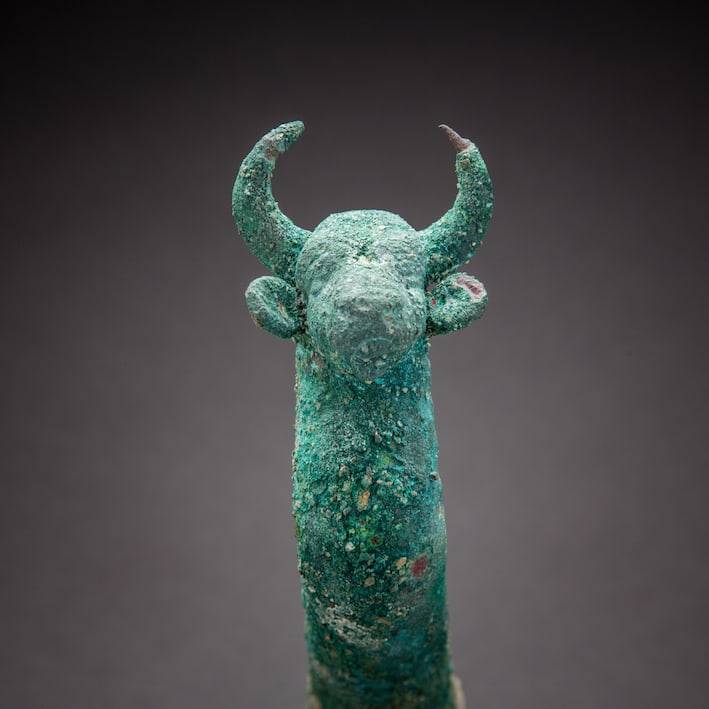Elamite Bronze Staff Finial Surmounted by a Bull, 1600 BCE - 900 BCE
Bronze
23.9 x 10.9 cm
9 3/8 x 4 1/4 in
9 3/8 x 4 1/4 in
LK.215
Elam was an ancient kingdom of Asia, situated north of the Persian Gulf and east of the Tigris River, and corresponding approximately to the present-day province of Khuzistan in Iran....
Elam was an ancient kingdom of Asia, situated north of the Persian Gulf and east of the Tigris River, and corresponding approximately to the present-day province of Khuzistan in Iran. The capital of Elam and its most fabled city was Susa, today the city of Shush. This powerful empire has been overshadowed in history by the rival kingdoms of Babylon and Assyria. However, the Elamite Empire deserves to be placed in a list of the world’s most important and influential ancient cultures. Archaeological signatures for the area exist as far back as the sixth millennium B.C. The empire itself was founded in around 3200 B.C., and it lasted – in various guises – almost continuously until the mid first millennium B.C.; much of its history is also documented using the world’s earliest deciphered alphabet, which makes it of extraordinary value to historians and archaeologists. The earliest phases are somewhat unclear.
The most extensively researched portions of the sequence start with the Old Elamite Period (OEP), which began around 2700 B.C. and saw the conquest of Elam by Enmebaragesi of Kish. King lists indicate a temporary domination of Sumer (Iraq) by later dynasties within the OEP, although Elam was herself briefly dominated by strong Sumerian rulers. Struggles with the Akkadians and repeated conquests in both directions characterized much of the Avan Dynasty; diplomatic relations between the Sumer and Elam improved, but perhaps only because the former’s power was waning. The Elamites sacked Ur in 2004 BC, and led Ibbi Sin into captivity. Later dynasties in the OEP saw burgeoning power structures throughout the Elamite Empire, leading to the rise of the Anshanite dynasties around 1500 B.C. and the arrival of the Middle Elamite Period (MEP).
Akkadian influence waned during this period, and Elamite gained strength; Elamite influence likewise burgeoned, capturing and sacking cities and artworks from the Babylonians and other neighbours. The power of the empire waned dramatically towards the end of the MEP with the inbred king Khutelutush-In- Shushinak, who was the product of his father and sister. Under his unsteady rule, the Elamite Empire fell into obscurity for almost three centuries, allowing their foes to reclaim their territory and plunder. The rise of the Neo- Elamite period is little understood, but in time the empire regained its former strength.
The most extensively researched portions of the sequence start with the Old Elamite Period (OEP), which began around 2700 B.C. and saw the conquest of Elam by Enmebaragesi of Kish. King lists indicate a temporary domination of Sumer (Iraq) by later dynasties within the OEP, although Elam was herself briefly dominated by strong Sumerian rulers. Struggles with the Akkadians and repeated conquests in both directions characterized much of the Avan Dynasty; diplomatic relations between the Sumer and Elam improved, but perhaps only because the former’s power was waning. The Elamites sacked Ur in 2004 BC, and led Ibbi Sin into captivity. Later dynasties in the OEP saw burgeoning power structures throughout the Elamite Empire, leading to the rise of the Anshanite dynasties around 1500 B.C. and the arrival of the Middle Elamite Period (MEP).
Akkadian influence waned during this period, and Elamite gained strength; Elamite influence likewise burgeoned, capturing and sacking cities and artworks from the Babylonians and other neighbours. The power of the empire waned dramatically towards the end of the MEP with the inbred king Khutelutush-In- Shushinak, who was the product of his father and sister. Under his unsteady rule, the Elamite Empire fell into obscurity for almost three centuries, allowing their foes to reclaim their territory and plunder. The rise of the Neo- Elamite period is little understood, but in time the empire regained its former strength.



